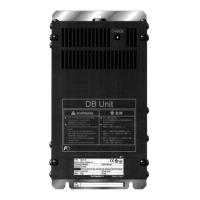the upstream power supply line, in order to avoid the entire power supply system's shutdown undesirable to
factory operation, install a residual-current-operated protective device (RCD)/earth leakage circuit breaker
(ELCB) individually to inverters to break the individual inverter power supply lines only.
Otherwise, a fire could occur.
• When wiring the inverter to the power source, insert a recommended molded case circuit breaker (MCCB) or
residual-current-operated protective device (RCD)/earth leakage circuit breaker (ELCB) (with overcurrent
protection) in the path of each pair of power lines to inverters. Use the recommended devices within the
recommended current capacity.
• Use wires in the specified size.
• Tighten terminals with specified torque.
Otherwise, a fire could occur.
• When there is more than one combination of an inverter and motor, do not use a multicore cable for the
purpose of handling their wirings together.
• Do not connect a surge killer to the inverter's output (secondary) circuit.
Doing so could cause a fire.
• Be sure to connect an optional DC reactor (DCR) when the capacity of the power supply transformer exceeds
500 kVA and is 10 times or more the inverter rated capacity.
Otherwise, a fire could occur.
• Ground the inverter in compliance with the national or local electric code.
• Be sure to ground the inverter's grounding terminals G.
Otherwise, an electric shock or a fire could occur.
• Qualified electricians should carry out wiring.
• Be sure to perform wiring after turning the power OFF.
Otherwise, an electric shock could occur.
• Be sure to perform wiring after installing the inverter unit.
Otherwise, an electric shock or injuries could occur.
• Ensure that the number of input phases and the rated voltage of the product match the number of phases and
the voltage of the AC power supply to which the product is to be connected.
Otherwise, a fire or an accident could occur.
• Do not connect the power supply wires to output terminals (U, V, and W).
• When connecting a DC braking resistor (DBR), never connect it to terminals other than terminals P(+) and
DB.
Doing so could cause fire or an accident.
• In general, sheaths of the control signal wires are not specifically designed to withstand a high voltage (i.e.,
reinforced insulation is not applied). Therefore, if a control signal wire comes into direct contact with a live
conductor of the main circuit, the insulation of the sheath might break down, which would expose the signal
wire to a high voltage of the main circuit. Make sure that the control signal wires will not come into contact
with live conductors of the main circuit.
Doing so could cause an accident or an electric shock.

